Auditing and Assurance
VerifiedAdded on 2023/04/22
|19
|4571
|449
AI Summary
The aim of the assignment is to conduct an audit programme on Target Energy Ltd by analyzing the financials of the company. The Audit Program covers the major aspect of the financials of the company and general information about the company covering the operational information and various other business and macro-economic environment factor analysis.
Contribute Materials
Your contribution can guide someone’s learning journey. Share your
documents today.
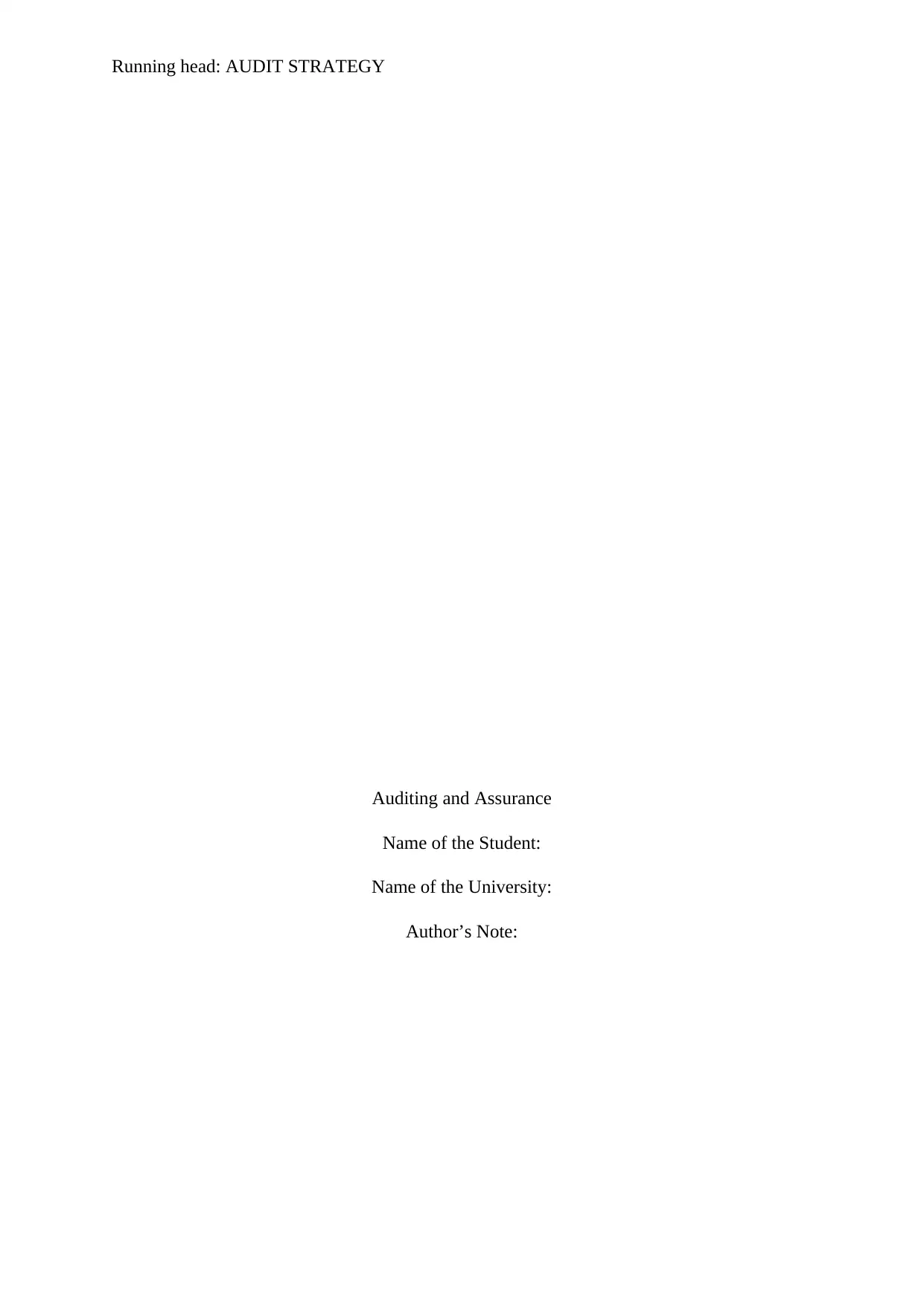
Running head: AUDIT STRATEGY
Auditing and Assurance
Name of the Student:
Name of the University:
Author’s Note:
Auditing and Assurance
Name of the Student:
Name of the University:
Author’s Note:
Secure Best Marks with AI Grader
Need help grading? Try our AI Grader for instant feedback on your assignments.
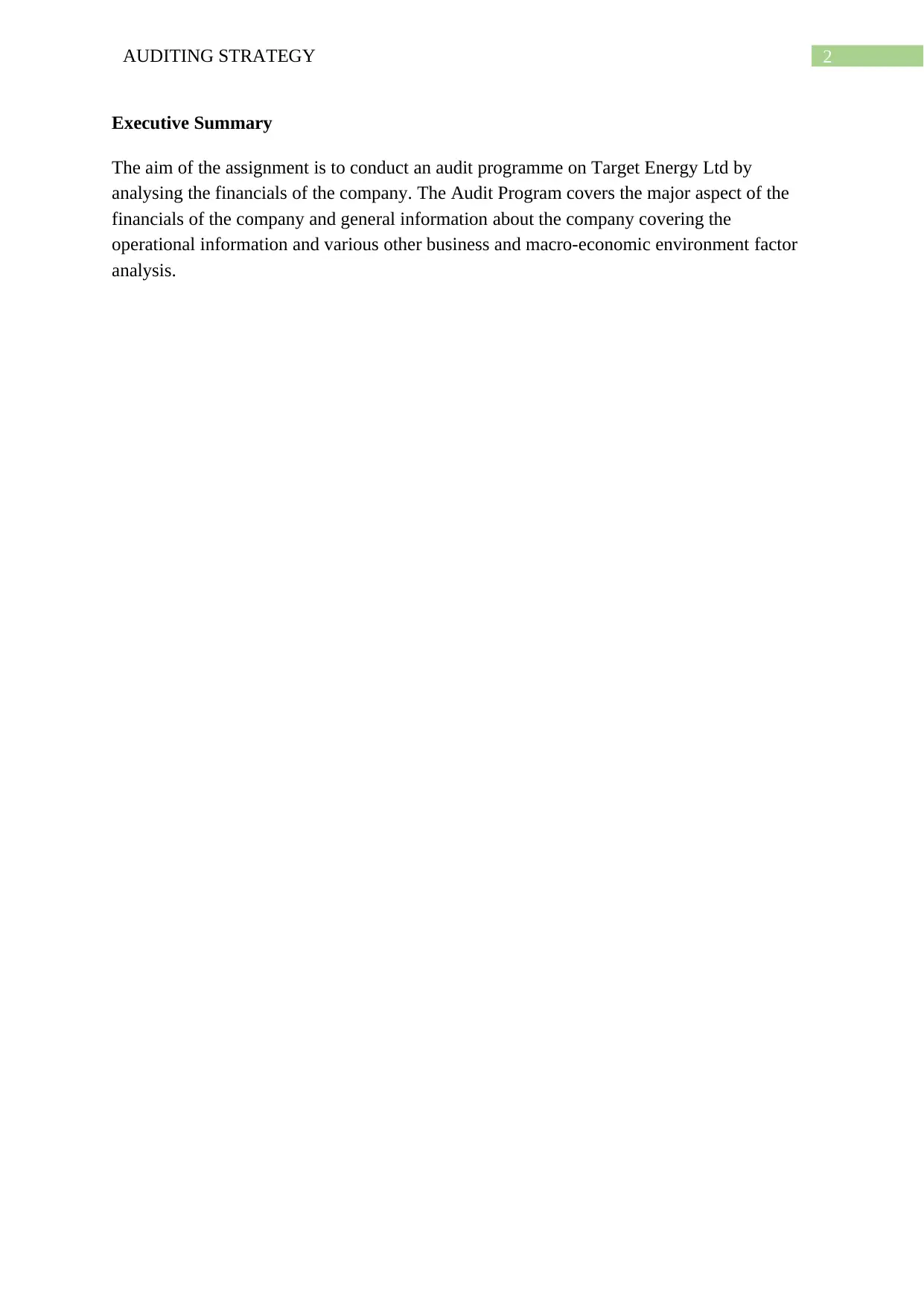
2AUDITING STRATEGY
Executive Summary
The aim of the assignment is to conduct an audit programme on Target Energy Ltd by
analysing the financials of the company. The Audit Program covers the major aspect of the
financials of the company and general information about the company covering the
operational information and various other business and macro-economic environment factor
analysis.
Executive Summary
The aim of the assignment is to conduct an audit programme on Target Energy Ltd by
analysing the financials of the company. The Audit Program covers the major aspect of the
financials of the company and general information about the company covering the
operational information and various other business and macro-economic environment factor
analysis.

3AUDITING STRATEGY
Table of Contents
1.0 Introduction.....................................................................................................................4
2.0 Part A: The Client................................................................................................................4
2.1 Information about the client.............................................................................................4
2.2 Industry Regulator and other external factor...................................................................4
2.3 Nature of Operations........................................................................................................5
2.4 Accounting Policy............................................................................................................6
2.5 Related Parties and Transactions with related parties......................................................7
Part B: Analysis of Clients and Impact on Future Audit Works................................................9
2.6 Accounting Policy Changes and their Impact..................................................................9
2.7 Preliminary Analytical Procedures................................................................................10
2.8 Financial Performance review and measurement..........................................................12
Conclusion................................................................................................................................13
References................................................................................................................................14
Appendix..................................................................................................................................16
Table of Contents
1.0 Introduction.....................................................................................................................4
2.0 Part A: The Client................................................................................................................4
2.1 Information about the client.............................................................................................4
2.2 Industry Regulator and other external factor...................................................................4
2.3 Nature of Operations........................................................................................................5
2.4 Accounting Policy............................................................................................................6
2.5 Related Parties and Transactions with related parties......................................................7
Part B: Analysis of Clients and Impact on Future Audit Works................................................9
2.6 Accounting Policy Changes and their Impact..................................................................9
2.7 Preliminary Analytical Procedures................................................................................10
2.8 Financial Performance review and measurement..........................................................12
Conclusion................................................................................................................................13
References................................................................................................................................14
Appendix..................................................................................................................................16
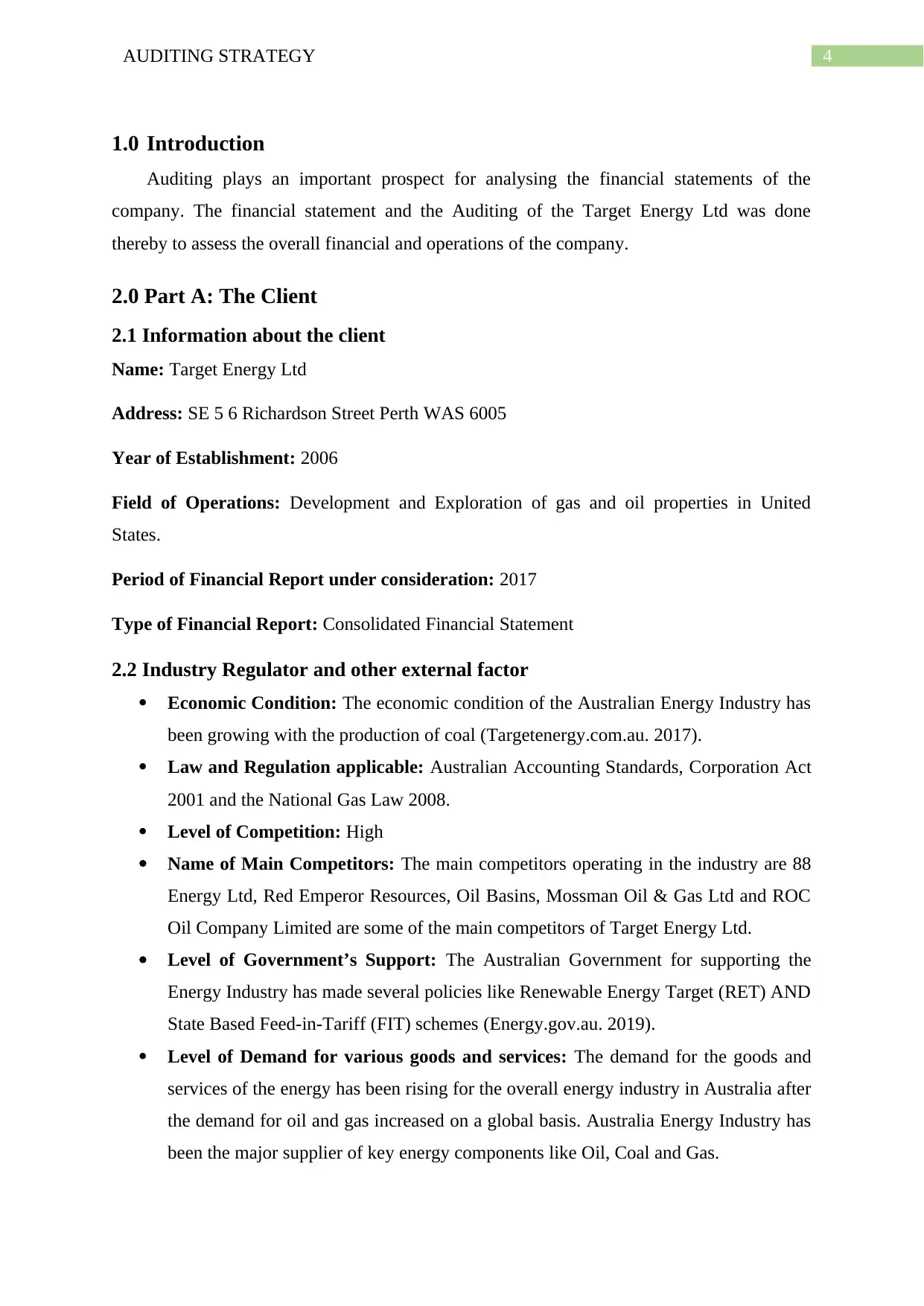
4AUDITING STRATEGY
1.0 Introduction
Auditing plays an important prospect for analysing the financial statements of the
company. The financial statement and the Auditing of the Target Energy Ltd was done
thereby to assess the overall financial and operations of the company.
2.0 Part A: The Client
2.1 Information about the client
Name: Target Energy Ltd
Address: SE 5 6 Richardson Street Perth WAS 6005
Year of Establishment: 2006
Field of Operations: Development and Exploration of gas and oil properties in United
States.
Period of Financial Report under consideration: 2017
Type of Financial Report: Consolidated Financial Statement
2.2 Industry Regulator and other external factor
Economic Condition: The economic condition of the Australian Energy Industry has
been growing with the production of coal (Targetenergy.com.au. 2017).
Law and Regulation applicable: Australian Accounting Standards, Corporation Act
2001 and the National Gas Law 2008.
Level of Competition: High
Name of Main Competitors: The main competitors operating in the industry are 88
Energy Ltd, Red Emperor Resources, Oil Basins, Mossman Oil & Gas Ltd and ROC
Oil Company Limited are some of the main competitors of Target Energy Ltd.
Level of Government’s Support: The Australian Government for supporting the
Energy Industry has made several policies like Renewable Energy Target (RET) AND
State Based Feed-in-Tariff (FIT) schemes (Energy.gov.au. 2019).
Level of Demand for various goods and services: The demand for the goods and
services of the energy has been rising for the overall energy industry in Australia after
the demand for oil and gas increased on a global basis. Australia Energy Industry has
been the major supplier of key energy components like Oil, Coal and Gas.
1.0 Introduction
Auditing plays an important prospect for analysing the financial statements of the
company. The financial statement and the Auditing of the Target Energy Ltd was done
thereby to assess the overall financial and operations of the company.
2.0 Part A: The Client
2.1 Information about the client
Name: Target Energy Ltd
Address: SE 5 6 Richardson Street Perth WAS 6005
Year of Establishment: 2006
Field of Operations: Development and Exploration of gas and oil properties in United
States.
Period of Financial Report under consideration: 2017
Type of Financial Report: Consolidated Financial Statement
2.2 Industry Regulator and other external factor
Economic Condition: The economic condition of the Australian Energy Industry has
been growing with the production of coal (Targetenergy.com.au. 2017).
Law and Regulation applicable: Australian Accounting Standards, Corporation Act
2001 and the National Gas Law 2008.
Level of Competition: High
Name of Main Competitors: The main competitors operating in the industry are 88
Energy Ltd, Red Emperor Resources, Oil Basins, Mossman Oil & Gas Ltd and ROC
Oil Company Limited are some of the main competitors of Target Energy Ltd.
Level of Government’s Support: The Australian Government for supporting the
Energy Industry has made several policies like Renewable Energy Target (RET) AND
State Based Feed-in-Tariff (FIT) schemes (Energy.gov.au. 2019).
Level of Demand for various goods and services: The demand for the goods and
services of the energy has been rising for the overall energy industry in Australia after
the demand for oil and gas increased on a global basis. Australia Energy Industry has
been the major supplier of key energy components like Oil, Coal and Gas.
Secure Best Marks with AI Grader
Need help grading? Try our AI Grader for instant feedback on your assignments.
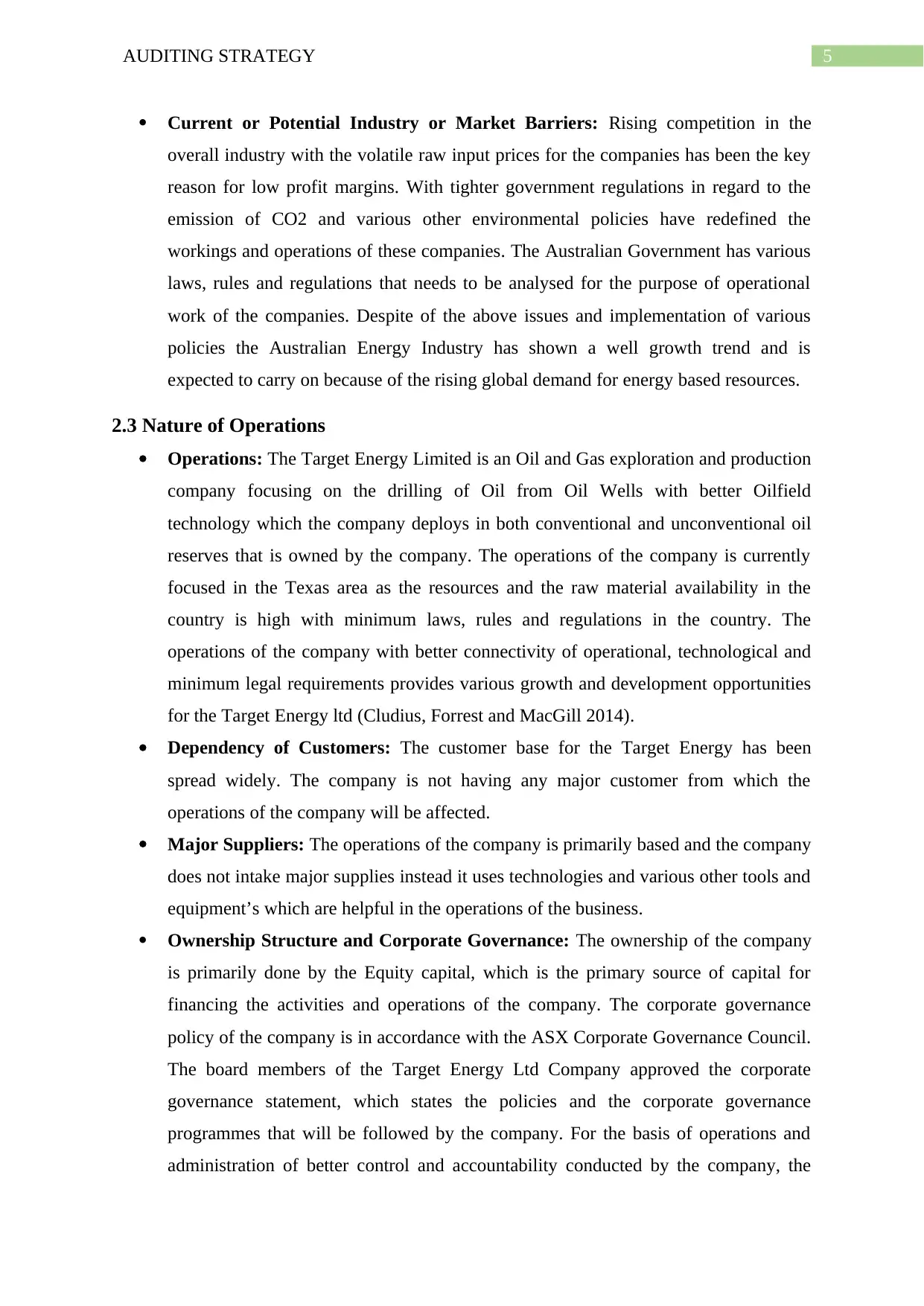
5AUDITING STRATEGY
Current or Potential Industry or Market Barriers: Rising competition in the
overall industry with the volatile raw input prices for the companies has been the key
reason for low profit margins. With tighter government regulations in regard to the
emission of CO2 and various other environmental policies have redefined the
workings and operations of these companies. The Australian Government has various
laws, rules and regulations that needs to be analysed for the purpose of operational
work of the companies. Despite of the above issues and implementation of various
policies the Australian Energy Industry has shown a well growth trend and is
expected to carry on because of the rising global demand for energy based resources.
2.3 Nature of Operations
Operations: The Target Energy Limited is an Oil and Gas exploration and production
company focusing on the drilling of Oil from Oil Wells with better Oilfield
technology which the company deploys in both conventional and unconventional oil
reserves that is owned by the company. The operations of the company is currently
focused in the Texas area as the resources and the raw material availability in the
country is high with minimum laws, rules and regulations in the country. The
operations of the company with better connectivity of operational, technological and
minimum legal requirements provides various growth and development opportunities
for the Target Energy ltd (Cludius, Forrest and MacGill 2014).
Dependency of Customers: The customer base for the Target Energy has been
spread widely. The company is not having any major customer from which the
operations of the company will be affected.
Major Suppliers: The operations of the company is primarily based and the company
does not intake major supplies instead it uses technologies and various other tools and
equipment’s which are helpful in the operations of the business.
Ownership Structure and Corporate Governance: The ownership of the company
is primarily done by the Equity capital, which is the primary source of capital for
financing the activities and operations of the company. The corporate governance
policy of the company is in accordance with the ASX Corporate Governance Council.
The board members of the Target Energy Ltd Company approved the corporate
governance statement, which states the policies and the corporate governance
programmes that will be followed by the company. For the basis of operations and
administration of better control and accountability conducted by the company, the
Current or Potential Industry or Market Barriers: Rising competition in the
overall industry with the volatile raw input prices for the companies has been the key
reason for low profit margins. With tighter government regulations in regard to the
emission of CO2 and various other environmental policies have redefined the
workings and operations of these companies. The Australian Government has various
laws, rules and regulations that needs to be analysed for the purpose of operational
work of the companies. Despite of the above issues and implementation of various
policies the Australian Energy Industry has shown a well growth trend and is
expected to carry on because of the rising global demand for energy based resources.
2.3 Nature of Operations
Operations: The Target Energy Limited is an Oil and Gas exploration and production
company focusing on the drilling of Oil from Oil Wells with better Oilfield
technology which the company deploys in both conventional and unconventional oil
reserves that is owned by the company. The operations of the company is currently
focused in the Texas area as the resources and the raw material availability in the
country is high with minimum laws, rules and regulations in the country. The
operations of the company with better connectivity of operational, technological and
minimum legal requirements provides various growth and development opportunities
for the Target Energy ltd (Cludius, Forrest and MacGill 2014).
Dependency of Customers: The customer base for the Target Energy has been
spread widely. The company is not having any major customer from which the
operations of the company will be affected.
Major Suppliers: The operations of the company is primarily based and the company
does not intake major supplies instead it uses technologies and various other tools and
equipment’s which are helpful in the operations of the business.
Ownership Structure and Corporate Governance: The ownership of the company
is primarily done by the Equity capital, which is the primary source of capital for
financing the activities and operations of the company. The corporate governance
policy of the company is in accordance with the ASX Corporate Governance Council.
The board members of the Target Energy Ltd Company approved the corporate
governance statement, which states the policies and the corporate governance
programmes that will be followed by the company. For the basis of operations and
administration of better control and accountability conducted by the company, the
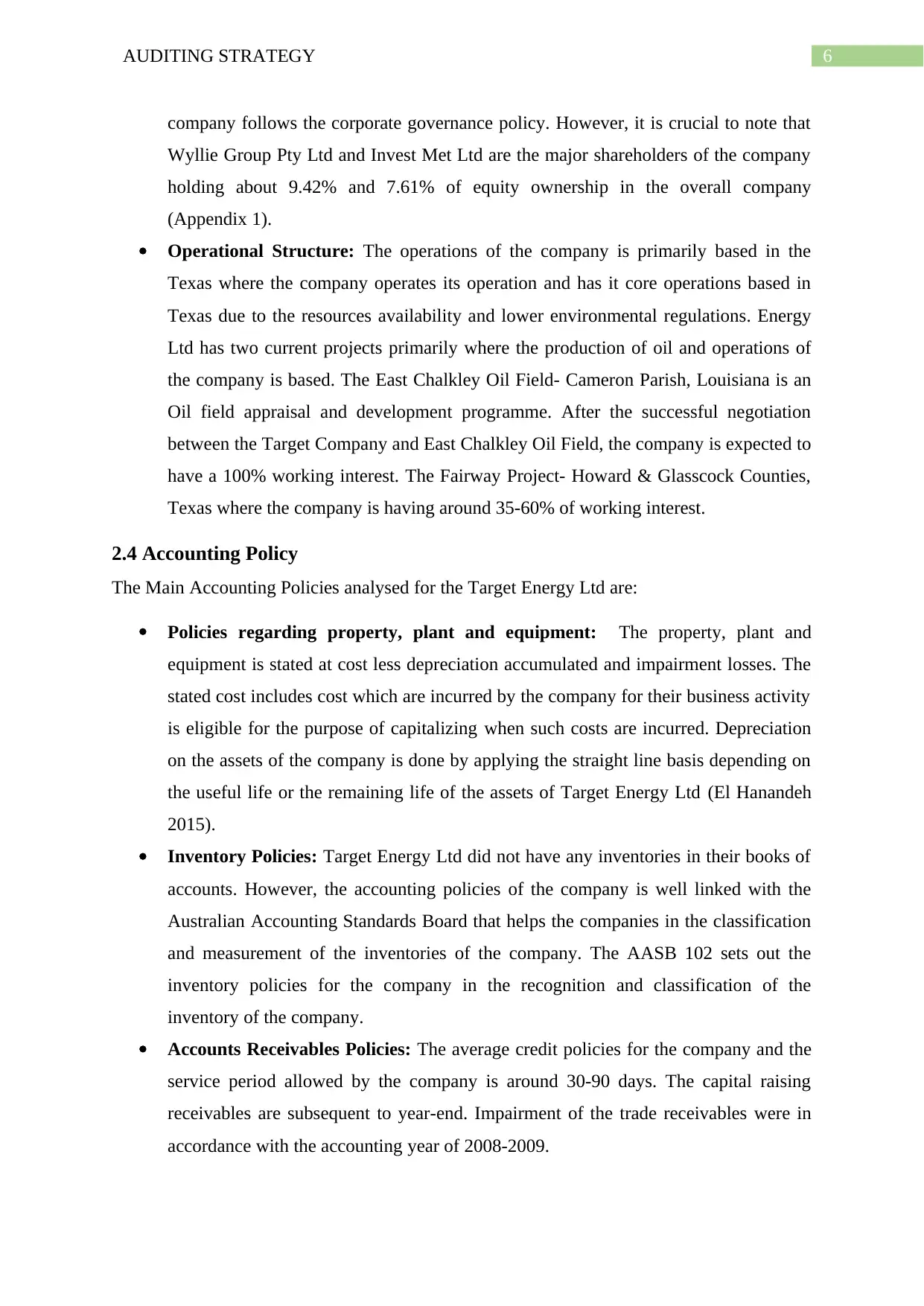
6AUDITING STRATEGY
company follows the corporate governance policy. However, it is crucial to note that
Wyllie Group Pty Ltd and Invest Met Ltd are the major shareholders of the company
holding about 9.42% and 7.61% of equity ownership in the overall company
(Appendix 1).
Operational Structure: The operations of the company is primarily based in the
Texas where the company operates its operation and has it core operations based in
Texas due to the resources availability and lower environmental regulations. Energy
Ltd has two current projects primarily where the production of oil and operations of
the company is based. The East Chalkley Oil Field- Cameron Parish, Louisiana is an
Oil field appraisal and development programme. After the successful negotiation
between the Target Company and East Chalkley Oil Field, the company is expected to
have a 100% working interest. The Fairway Project- Howard & Glasscock Counties,
Texas where the company is having around 35-60% of working interest.
2.4 Accounting Policy
The Main Accounting Policies analysed for the Target Energy Ltd are:
Policies regarding property, plant and equipment: The property, plant and
equipment is stated at cost less depreciation accumulated and impairment losses. The
stated cost includes cost which are incurred by the company for their business activity
is eligible for the purpose of capitalizing when such costs are incurred. Depreciation
on the assets of the company is done by applying the straight line basis depending on
the useful life or the remaining life of the assets of Target Energy Ltd (El Hanandeh
2015).
Inventory Policies: Target Energy Ltd did not have any inventories in their books of
accounts. However, the accounting policies of the company is well linked with the
Australian Accounting Standards Board that helps the companies in the classification
and measurement of the inventories of the company. The AASB 102 sets out the
inventory policies for the company in the recognition and classification of the
inventory of the company.
Accounts Receivables Policies: The average credit policies for the company and the
service period allowed by the company is around 30-90 days. The capital raising
receivables are subsequent to year-end. Impairment of the trade receivables were in
accordance with the accounting year of 2008-2009.
company follows the corporate governance policy. However, it is crucial to note that
Wyllie Group Pty Ltd and Invest Met Ltd are the major shareholders of the company
holding about 9.42% and 7.61% of equity ownership in the overall company
(Appendix 1).
Operational Structure: The operations of the company is primarily based in the
Texas where the company operates its operation and has it core operations based in
Texas due to the resources availability and lower environmental regulations. Energy
Ltd has two current projects primarily where the production of oil and operations of
the company is based. The East Chalkley Oil Field- Cameron Parish, Louisiana is an
Oil field appraisal and development programme. After the successful negotiation
between the Target Company and East Chalkley Oil Field, the company is expected to
have a 100% working interest. The Fairway Project- Howard & Glasscock Counties,
Texas where the company is having around 35-60% of working interest.
2.4 Accounting Policy
The Main Accounting Policies analysed for the Target Energy Ltd are:
Policies regarding property, plant and equipment: The property, plant and
equipment is stated at cost less depreciation accumulated and impairment losses. The
stated cost includes cost which are incurred by the company for their business activity
is eligible for the purpose of capitalizing when such costs are incurred. Depreciation
on the assets of the company is done by applying the straight line basis depending on
the useful life or the remaining life of the assets of Target Energy Ltd (El Hanandeh
2015).
Inventory Policies: Target Energy Ltd did not have any inventories in their books of
accounts. However, the accounting policies of the company is well linked with the
Australian Accounting Standards Board that helps the companies in the classification
and measurement of the inventories of the company. The AASB 102 sets out the
inventory policies for the company in the recognition and classification of the
inventory of the company.
Accounts Receivables Policies: The average credit policies for the company and the
service period allowed by the company is around 30-90 days. The capital raising
receivables are subsequent to year-end. Impairment of the trade receivables were in
accordance with the accounting year of 2008-2009.
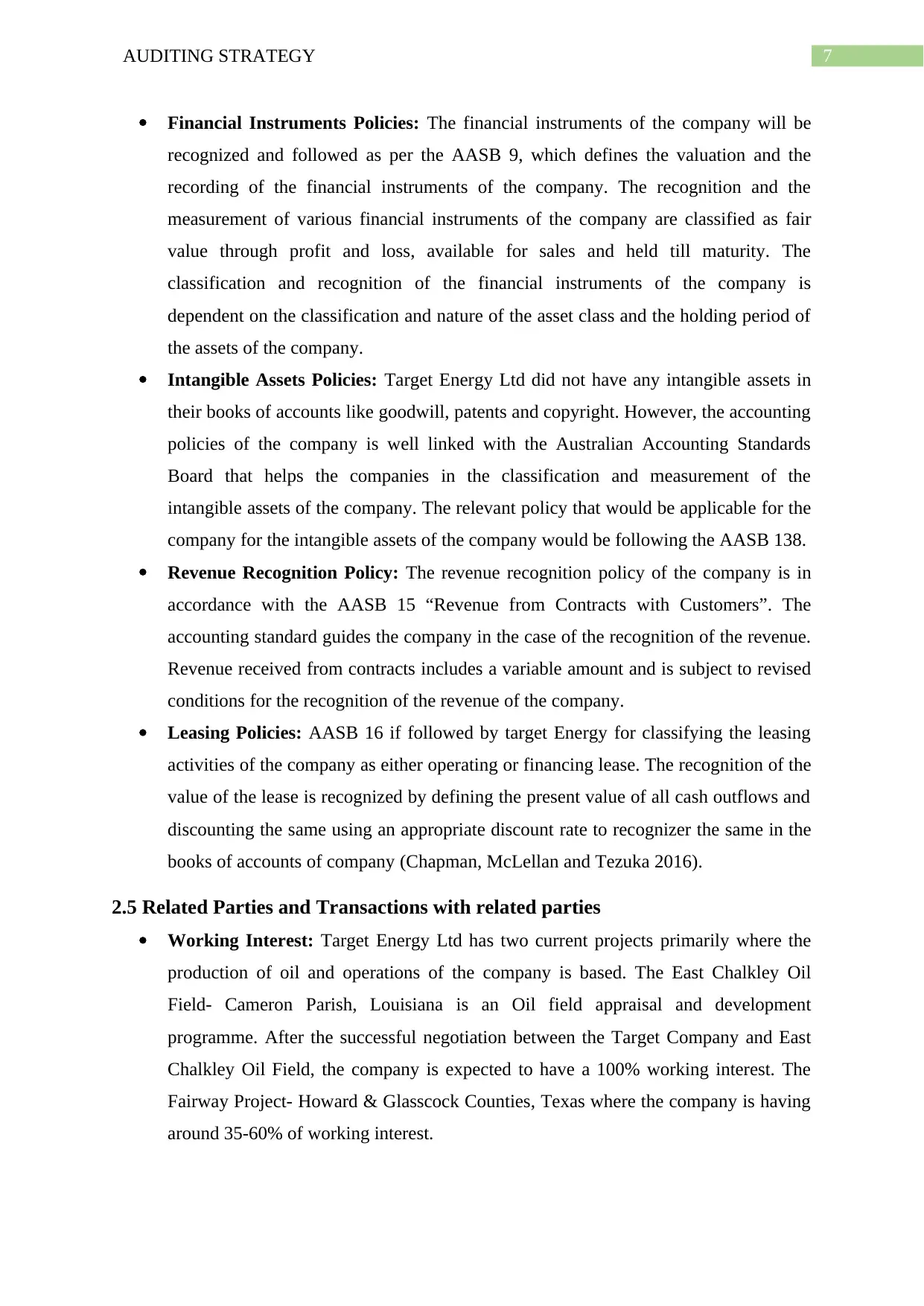
7AUDITING STRATEGY
Financial Instruments Policies: The financial instruments of the company will be
recognized and followed as per the AASB 9, which defines the valuation and the
recording of the financial instruments of the company. The recognition and the
measurement of various financial instruments of the company are classified as fair
value through profit and loss, available for sales and held till maturity. The
classification and recognition of the financial instruments of the company is
dependent on the classification and nature of the asset class and the holding period of
the assets of the company.
Intangible Assets Policies: Target Energy Ltd did not have any intangible assets in
their books of accounts like goodwill, patents and copyright. However, the accounting
policies of the company is well linked with the Australian Accounting Standards
Board that helps the companies in the classification and measurement of the
intangible assets of the company. The relevant policy that would be applicable for the
company for the intangible assets of the company would be following the AASB 138.
Revenue Recognition Policy: The revenue recognition policy of the company is in
accordance with the AASB 15 “Revenue from Contracts with Customers”. The
accounting standard guides the company in the case of the recognition of the revenue.
Revenue received from contracts includes a variable amount and is subject to revised
conditions for the recognition of the revenue of the company.
Leasing Policies: AASB 16 if followed by target Energy for classifying the leasing
activities of the company as either operating or financing lease. The recognition of the
value of the lease is recognized by defining the present value of all cash outflows and
discounting the same using an appropriate discount rate to recognizer the same in the
books of accounts of company (Chapman, McLellan and Tezuka 2016).
2.5 Related Parties and Transactions with related parties
Working Interest: Target Energy Ltd has two current projects primarily where the
production of oil and operations of the company is based. The East Chalkley Oil
Field- Cameron Parish, Louisiana is an Oil field appraisal and development
programme. After the successful negotiation between the Target Company and East
Chalkley Oil Field, the company is expected to have a 100% working interest. The
Fairway Project- Howard & Glasscock Counties, Texas where the company is having
around 35-60% of working interest.
Financial Instruments Policies: The financial instruments of the company will be
recognized and followed as per the AASB 9, which defines the valuation and the
recording of the financial instruments of the company. The recognition and the
measurement of various financial instruments of the company are classified as fair
value through profit and loss, available for sales and held till maturity. The
classification and recognition of the financial instruments of the company is
dependent on the classification and nature of the asset class and the holding period of
the assets of the company.
Intangible Assets Policies: Target Energy Ltd did not have any intangible assets in
their books of accounts like goodwill, patents and copyright. However, the accounting
policies of the company is well linked with the Australian Accounting Standards
Board that helps the companies in the classification and measurement of the
intangible assets of the company. The relevant policy that would be applicable for the
company for the intangible assets of the company would be following the AASB 138.
Revenue Recognition Policy: The revenue recognition policy of the company is in
accordance with the AASB 15 “Revenue from Contracts with Customers”. The
accounting standard guides the company in the case of the recognition of the revenue.
Revenue received from contracts includes a variable amount and is subject to revised
conditions for the recognition of the revenue of the company.
Leasing Policies: AASB 16 if followed by target Energy for classifying the leasing
activities of the company as either operating or financing lease. The recognition of the
value of the lease is recognized by defining the present value of all cash outflows and
discounting the same using an appropriate discount rate to recognizer the same in the
books of accounts of company (Chapman, McLellan and Tezuka 2016).
2.5 Related Parties and Transactions with related parties
Working Interest: Target Energy Ltd has two current projects primarily where the
production of oil and operations of the company is based. The East Chalkley Oil
Field- Cameron Parish, Louisiana is an Oil field appraisal and development
programme. After the successful negotiation between the Target Company and East
Chalkley Oil Field, the company is expected to have a 100% working interest. The
Fairway Project- Howard & Glasscock Counties, Texas where the company is having
around 35-60% of working interest.
Paraphrase This Document
Need a fresh take? Get an instant paraphrase of this document with our AI Paraphraser
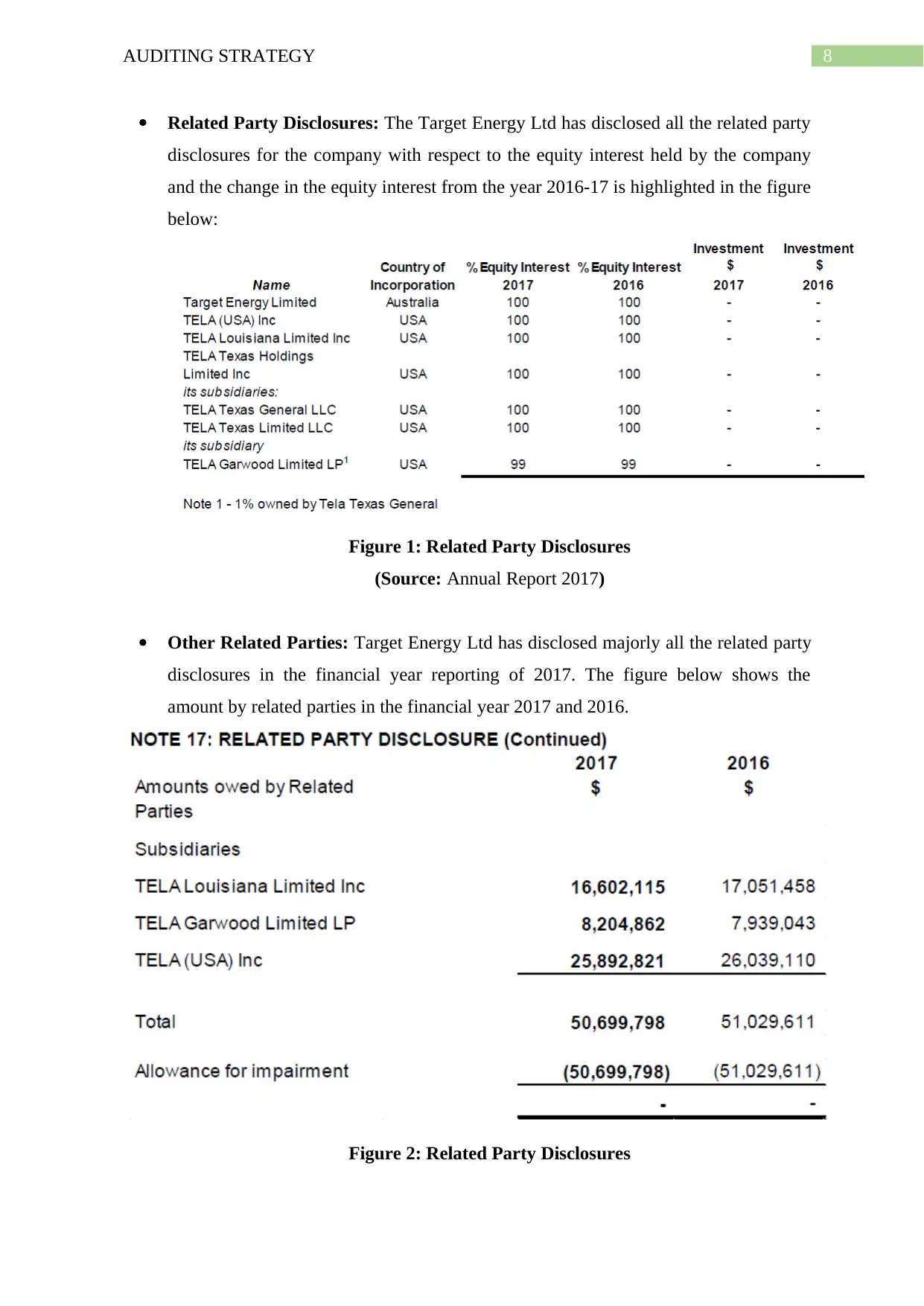
8AUDITING STRATEGY
Related Party Disclosures: The Target Energy Ltd has disclosed all the related party
disclosures for the company with respect to the equity interest held by the company
and the change in the equity interest from the year 2016-17 is highlighted in the figure
below:
Figure 1: Related Party Disclosures
(Source: Annual Report 2017)
Other Related Parties: Target Energy Ltd has disclosed majorly all the related party
disclosures in the financial year reporting of 2017. The figure below shows the
amount by related parties in the financial year 2017 and 2016.
Figure 2: Related Party Disclosures
Related Party Disclosures: The Target Energy Ltd has disclosed all the related party
disclosures for the company with respect to the equity interest held by the company
and the change in the equity interest from the year 2016-17 is highlighted in the figure
below:
Figure 1: Related Party Disclosures
(Source: Annual Report 2017)
Other Related Parties: Target Energy Ltd has disclosed majorly all the related party
disclosures in the financial year reporting of 2017. The figure below shows the
amount by related parties in the financial year 2017 and 2016.
Figure 2: Related Party Disclosures
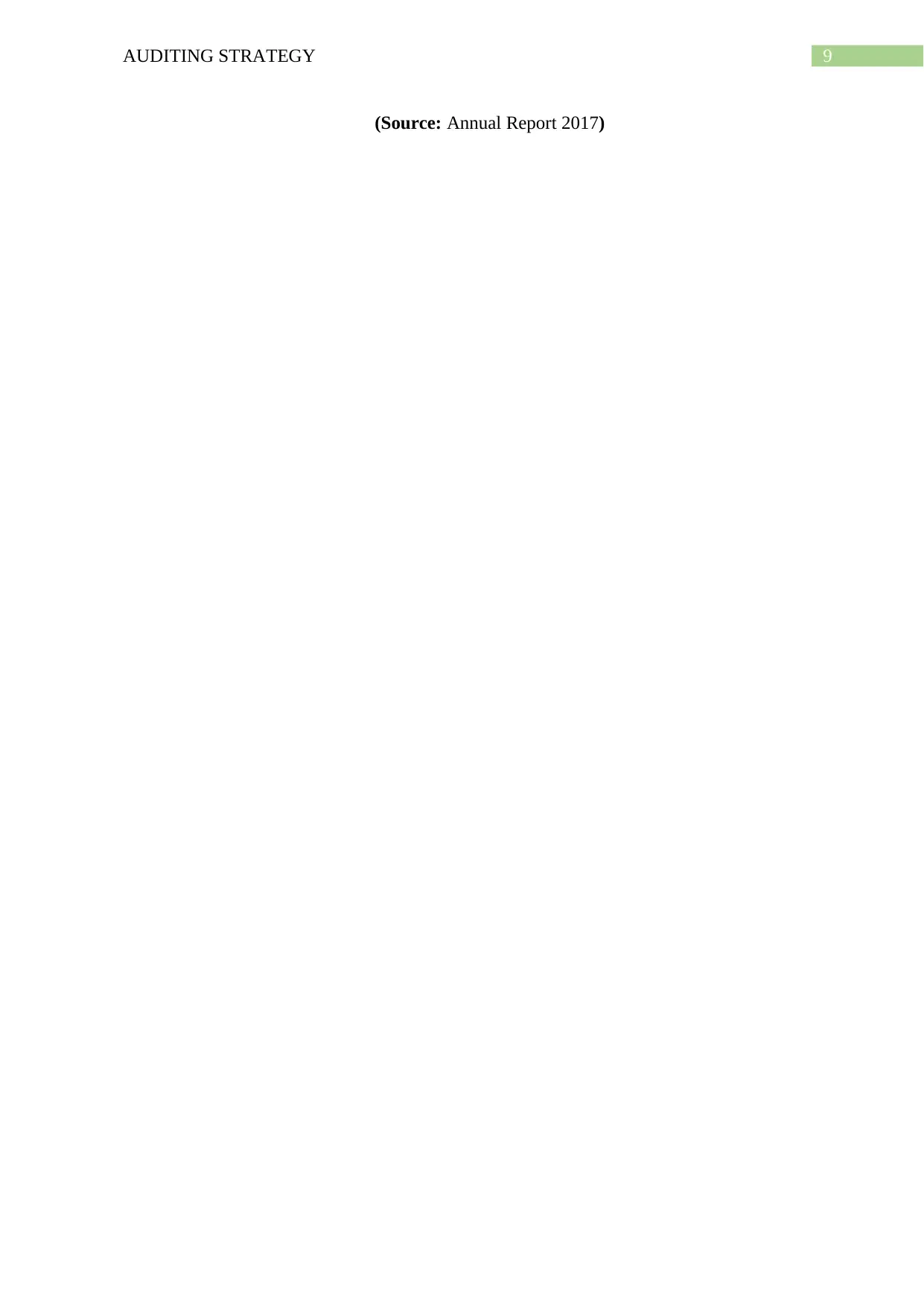
9AUDITING STRATEGY
(Source: Annual Report 2017)
(Source: Annual Report 2017)

10AUDITING STRATEGY
Part B: Analysis of Clients and Impact on Future Audit Works
2.6 Accounting Policy Changes and their Impact
Change in Accounting Policies and their Impact: The Company Target Energy Ltd
has reviewed all the new and revised standards of the Australian Accounting
Standards. It has also discussed the implementation of the new policies in the books
of accounts for the company, which are outlined below:
AASB 9 Financial Instruments: The AASB 9 (2014), replaces the existing
financial standards on the financial instruments, which was previously done
with the help of the AASB 9 (2009), (2010), and AASB 139 (Christensen et
al. 2016). The Company has reconsidered the accounting policies and has
made required impairment for the recognition and classification of the
financial instruments in accordance with the AASB (2014).
AASB 15 Revenue Recognition: The introduction of the AASB 15 removes
the existing accounting standard AASB 111 Construction contracts, AASB
118 Revenue recognition and AASB 104 Contribution. The new accounting
standards guides the company based on criteria for recognizing the revenue
and the aspects for the recognition of the revenue for the company (Tepalagul
and Lin 2015).
AASB 16 Leases: The AASB 16 Leases is a more classified and detailed
leasing standard for various operating and financing lease activities, which
will replace the old AASB 17 leasing standards (Jha and Chen 2014). The
AASB 16 recognizes all the leasing activities of the company on the financial
statement company thereby capitalizing the lease of the company with the help
of the discounting and capitalizing the same in the books of accounts for the
company (Pizzini, Lin and Ziegenfuss 2014).
Expected Impact because of Accounting Policies Change: The change in the
accounting policies of the company will be affecting the financial and books of
accounts for the company (Simshauser 2014).
Financial Instruments: The current impairment policy for the company will
be based on forward looking “expected loss model” which was initially as
incurred loss model for the company (Krarti 2016). The change in the
Part B: Analysis of Clients and Impact on Future Audit Works
2.6 Accounting Policy Changes and their Impact
Change in Accounting Policies and their Impact: The Company Target Energy Ltd
has reviewed all the new and revised standards of the Australian Accounting
Standards. It has also discussed the implementation of the new policies in the books
of accounts for the company, which are outlined below:
AASB 9 Financial Instruments: The AASB 9 (2014), replaces the existing
financial standards on the financial instruments, which was previously done
with the help of the AASB 9 (2009), (2010), and AASB 139 (Christensen et
al. 2016). The Company has reconsidered the accounting policies and has
made required impairment for the recognition and classification of the
financial instruments in accordance with the AASB (2014).
AASB 15 Revenue Recognition: The introduction of the AASB 15 removes
the existing accounting standard AASB 111 Construction contracts, AASB
118 Revenue recognition and AASB 104 Contribution. The new accounting
standards guides the company based on criteria for recognizing the revenue
and the aspects for the recognition of the revenue for the company (Tepalagul
and Lin 2015).
AASB 16 Leases: The AASB 16 Leases is a more classified and detailed
leasing standard for various operating and financing lease activities, which
will replace the old AASB 17 leasing standards (Jha and Chen 2014). The
AASB 16 recognizes all the leasing activities of the company on the financial
statement company thereby capitalizing the lease of the company with the help
of the discounting and capitalizing the same in the books of accounts for the
company (Pizzini, Lin and Ziegenfuss 2014).
Expected Impact because of Accounting Policies Change: The change in the
accounting policies of the company will be affecting the financial and books of
accounts for the company (Simshauser 2014).
Financial Instruments: The current impairment policy for the company will
be based on forward looking “expected loss model” which was initially as
incurred loss model for the company (Krarti 2016). The change in the
Secure Best Marks with AI Grader
Need help grading? Try our AI Grader for instant feedback on your assignments.
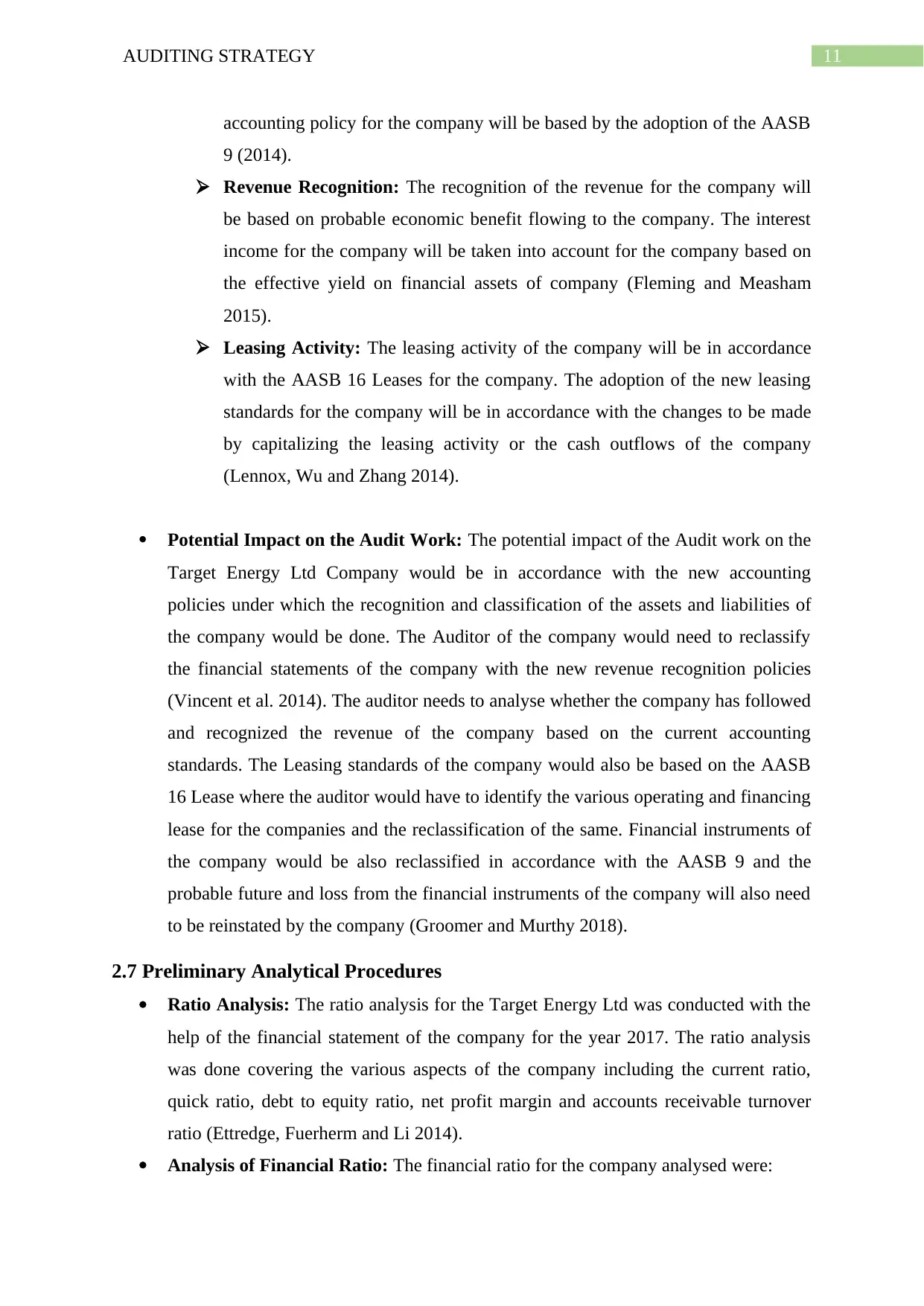
11AUDITING STRATEGY
accounting policy for the company will be based by the adoption of the AASB
9 (2014).
Revenue Recognition: The recognition of the revenue for the company will
be based on probable economic benefit flowing to the company. The interest
income for the company will be taken into account for the company based on
the effective yield on financial assets of company (Fleming and Measham
2015).
Leasing Activity: The leasing activity of the company will be in accordance
with the AASB 16 Leases for the company. The adoption of the new leasing
standards for the company will be in accordance with the changes to be made
by capitalizing the leasing activity or the cash outflows of the company
(Lennox, Wu and Zhang 2014).
Potential Impact on the Audit Work: The potential impact of the Audit work on the
Target Energy Ltd Company would be in accordance with the new accounting
policies under which the recognition and classification of the assets and liabilities of
the company would be done. The Auditor of the company would need to reclassify
the financial statements of the company with the new revenue recognition policies
(Vincent et al. 2014). The auditor needs to analyse whether the company has followed
and recognized the revenue of the company based on the current accounting
standards. The Leasing standards of the company would also be based on the AASB
16 Lease where the auditor would have to identify the various operating and financing
lease for the companies and the reclassification of the same. Financial instruments of
the company would be also reclassified in accordance with the AASB 9 and the
probable future and loss from the financial instruments of the company will also need
to be reinstated by the company (Groomer and Murthy 2018).
2.7 Preliminary Analytical Procedures
Ratio Analysis: The ratio analysis for the Target Energy Ltd was conducted with the
help of the financial statement of the company for the year 2017. The ratio analysis
was done covering the various aspects of the company including the current ratio,
quick ratio, debt to equity ratio, net profit margin and accounts receivable turnover
ratio (Ettredge, Fuerherm and Li 2014).
Analysis of Financial Ratio: The financial ratio for the company analysed were:
accounting policy for the company will be based by the adoption of the AASB
9 (2014).
Revenue Recognition: The recognition of the revenue for the company will
be based on probable economic benefit flowing to the company. The interest
income for the company will be taken into account for the company based on
the effective yield on financial assets of company (Fleming and Measham
2015).
Leasing Activity: The leasing activity of the company will be in accordance
with the AASB 16 Leases for the company. The adoption of the new leasing
standards for the company will be in accordance with the changes to be made
by capitalizing the leasing activity or the cash outflows of the company
(Lennox, Wu and Zhang 2014).
Potential Impact on the Audit Work: The potential impact of the Audit work on the
Target Energy Ltd Company would be in accordance with the new accounting
policies under which the recognition and classification of the assets and liabilities of
the company would be done. The Auditor of the company would need to reclassify
the financial statements of the company with the new revenue recognition policies
(Vincent et al. 2014). The auditor needs to analyse whether the company has followed
and recognized the revenue of the company based on the current accounting
standards. The Leasing standards of the company would also be based on the AASB
16 Lease where the auditor would have to identify the various operating and financing
lease for the companies and the reclassification of the same. Financial instruments of
the company would be also reclassified in accordance with the AASB 9 and the
probable future and loss from the financial instruments of the company will also need
to be reinstated by the company (Groomer and Murthy 2018).
2.7 Preliminary Analytical Procedures
Ratio Analysis: The ratio analysis for the Target Energy Ltd was conducted with the
help of the financial statement of the company for the year 2017. The ratio analysis
was done covering the various aspects of the company including the current ratio,
quick ratio, debt to equity ratio, net profit margin and accounts receivable turnover
ratio (Ettredge, Fuerherm and Li 2014).
Analysis of Financial Ratio: The financial ratio for the company analysed were:
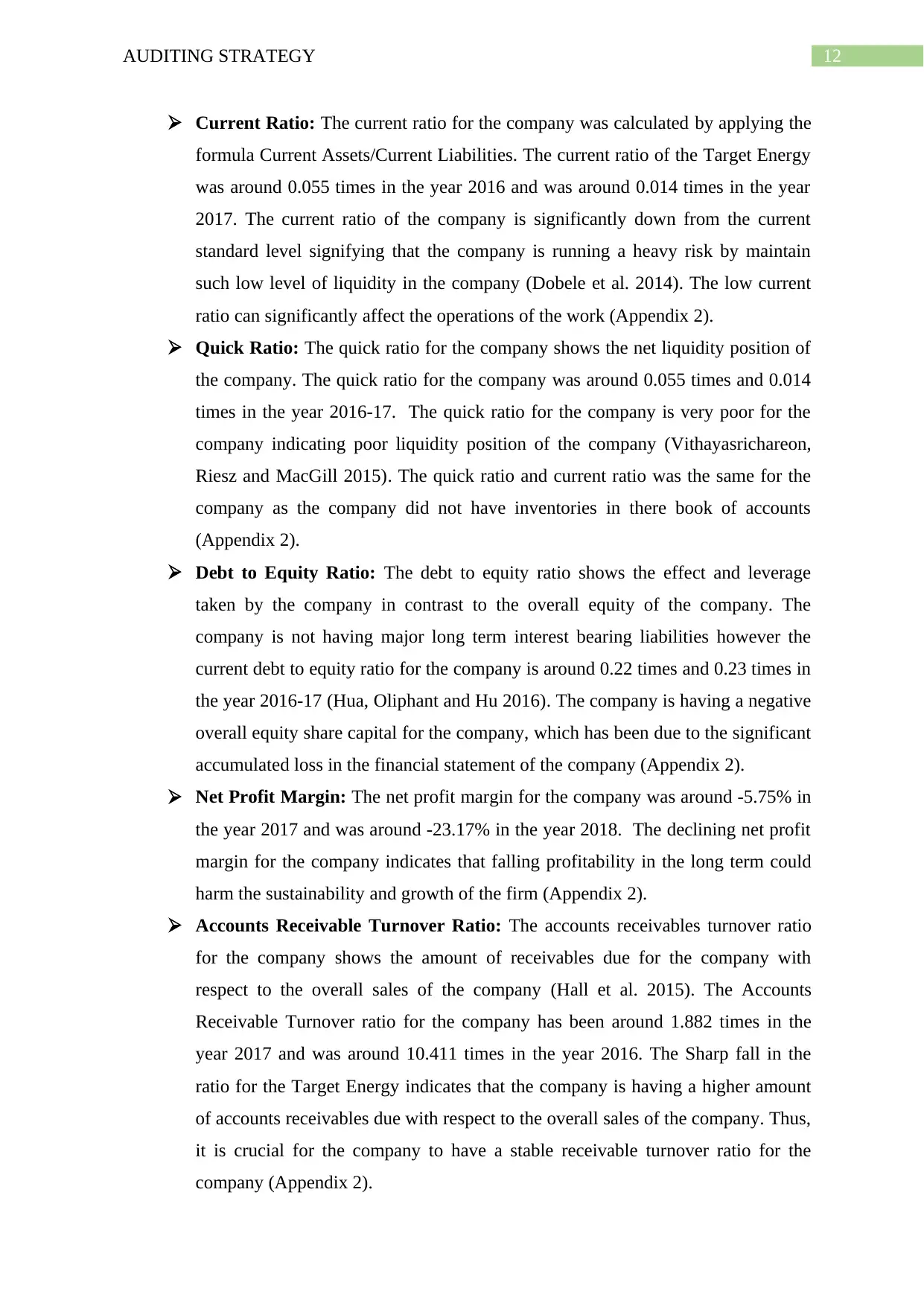
12AUDITING STRATEGY
Current Ratio: The current ratio for the company was calculated by applying the
formula Current Assets/Current Liabilities. The current ratio of the Target Energy
was around 0.055 times in the year 2016 and was around 0.014 times in the year
2017. The current ratio of the company is significantly down from the current
standard level signifying that the company is running a heavy risk by maintain
such low level of liquidity in the company (Dobele et al. 2014). The low current
ratio can significantly affect the operations of the work (Appendix 2).
Quick Ratio: The quick ratio for the company shows the net liquidity position of
the company. The quick ratio for the company was around 0.055 times and 0.014
times in the year 2016-17. The quick ratio for the company is very poor for the
company indicating poor liquidity position of the company (Vithayasrichareon,
Riesz and MacGill 2015). The quick ratio and current ratio was the same for the
company as the company did not have inventories in there book of accounts
(Appendix 2).
Debt to Equity Ratio: The debt to equity ratio shows the effect and leverage
taken by the company in contrast to the overall equity of the company. The
company is not having major long term interest bearing liabilities however the
current debt to equity ratio for the company is around 0.22 times and 0.23 times in
the year 2016-17 (Hua, Oliphant and Hu 2016). The company is having a negative
overall equity share capital for the company, which has been due to the significant
accumulated loss in the financial statement of the company (Appendix 2).
Net Profit Margin: The net profit margin for the company was around -5.75% in
the year 2017 and was around -23.17% in the year 2018. The declining net profit
margin for the company indicates that falling profitability in the long term could
harm the sustainability and growth of the firm (Appendix 2).
Accounts Receivable Turnover Ratio: The accounts receivables turnover ratio
for the company shows the amount of receivables due for the company with
respect to the overall sales of the company (Hall et al. 2015). The Accounts
Receivable Turnover ratio for the company has been around 1.882 times in the
year 2017 and was around 10.411 times in the year 2016. The Sharp fall in the
ratio for the Target Energy indicates that the company is having a higher amount
of accounts receivables due with respect to the overall sales of the company. Thus,
it is crucial for the company to have a stable receivable turnover ratio for the
company (Appendix 2).
Current Ratio: The current ratio for the company was calculated by applying the
formula Current Assets/Current Liabilities. The current ratio of the Target Energy
was around 0.055 times in the year 2016 and was around 0.014 times in the year
2017. The current ratio of the company is significantly down from the current
standard level signifying that the company is running a heavy risk by maintain
such low level of liquidity in the company (Dobele et al. 2014). The low current
ratio can significantly affect the operations of the work (Appendix 2).
Quick Ratio: The quick ratio for the company shows the net liquidity position of
the company. The quick ratio for the company was around 0.055 times and 0.014
times in the year 2016-17. The quick ratio for the company is very poor for the
company indicating poor liquidity position of the company (Vithayasrichareon,
Riesz and MacGill 2015). The quick ratio and current ratio was the same for the
company as the company did not have inventories in there book of accounts
(Appendix 2).
Debt to Equity Ratio: The debt to equity ratio shows the effect and leverage
taken by the company in contrast to the overall equity of the company. The
company is not having major long term interest bearing liabilities however the
current debt to equity ratio for the company is around 0.22 times and 0.23 times in
the year 2016-17 (Hua, Oliphant and Hu 2016). The company is having a negative
overall equity share capital for the company, which has been due to the significant
accumulated loss in the financial statement of the company (Appendix 2).
Net Profit Margin: The net profit margin for the company was around -5.75% in
the year 2017 and was around -23.17% in the year 2018. The declining net profit
margin for the company indicates that falling profitability in the long term could
harm the sustainability and growth of the firm (Appendix 2).
Accounts Receivable Turnover Ratio: The accounts receivables turnover ratio
for the company shows the amount of receivables due for the company with
respect to the overall sales of the company (Hall et al. 2015). The Accounts
Receivable Turnover ratio for the company has been around 1.882 times in the
year 2017 and was around 10.411 times in the year 2016. The Sharp fall in the
ratio for the Target Energy indicates that the company is having a higher amount
of accounts receivables due with respect to the overall sales of the company. Thus,
it is crucial for the company to have a stable receivable turnover ratio for the
company (Appendix 2).
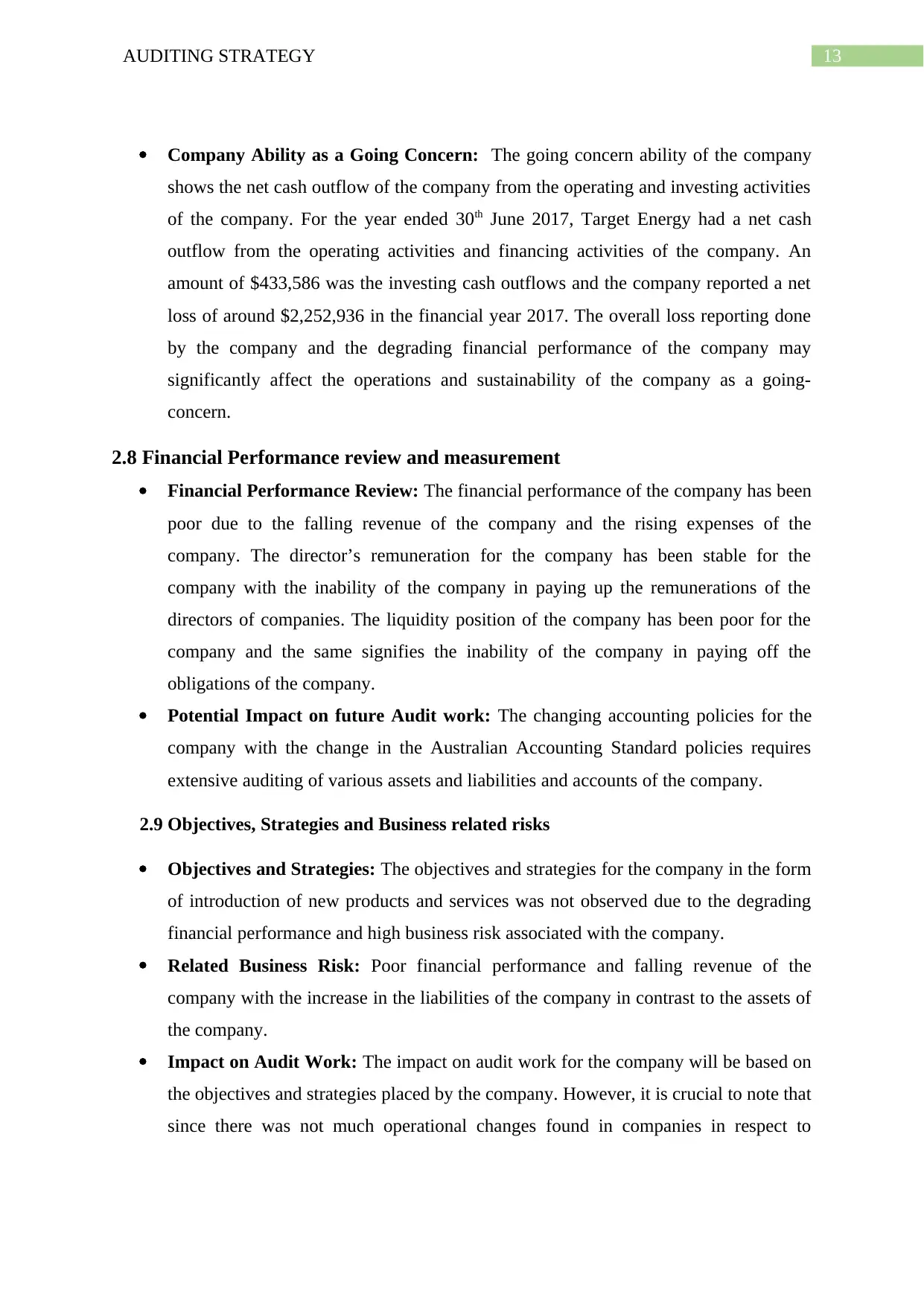
13AUDITING STRATEGY
Company Ability as a Going Concern: The going concern ability of the company
shows the net cash outflow of the company from the operating and investing activities
of the company. For the year ended 30th June 2017, Target Energy had a net cash
outflow from the operating activities and financing activities of the company. An
amount of $433,586 was the investing cash outflows and the company reported a net
loss of around $2,252,936 in the financial year 2017. The overall loss reporting done
by the company and the degrading financial performance of the company may
significantly affect the operations and sustainability of the company as a going-
concern.
2.8 Financial Performance review and measurement
Financial Performance Review: The financial performance of the company has been
poor due to the falling revenue of the company and the rising expenses of the
company. The director’s remuneration for the company has been stable for the
company with the inability of the company in paying up the remunerations of the
directors of companies. The liquidity position of the company has been poor for the
company and the same signifies the inability of the company in paying off the
obligations of the company.
Potential Impact on future Audit work: The changing accounting policies for the
company with the change in the Australian Accounting Standard policies requires
extensive auditing of various assets and liabilities and accounts of the company.
2.9 Objectives, Strategies and Business related risks
Objectives and Strategies: The objectives and strategies for the company in the form
of introduction of new products and services was not observed due to the degrading
financial performance and high business risk associated with the company.
Related Business Risk: Poor financial performance and falling revenue of the
company with the increase in the liabilities of the company in contrast to the assets of
the company.
Impact on Audit Work: The impact on audit work for the company will be based on
the objectives and strategies placed by the company. However, it is crucial to note that
since there was not much operational changes found in companies in respect to
Company Ability as a Going Concern: The going concern ability of the company
shows the net cash outflow of the company from the operating and investing activities
of the company. For the year ended 30th June 2017, Target Energy had a net cash
outflow from the operating activities and financing activities of the company. An
amount of $433,586 was the investing cash outflows and the company reported a net
loss of around $2,252,936 in the financial year 2017. The overall loss reporting done
by the company and the degrading financial performance of the company may
significantly affect the operations and sustainability of the company as a going-
concern.
2.8 Financial Performance review and measurement
Financial Performance Review: The financial performance of the company has been
poor due to the falling revenue of the company and the rising expenses of the
company. The director’s remuneration for the company has been stable for the
company with the inability of the company in paying up the remunerations of the
directors of companies. The liquidity position of the company has been poor for the
company and the same signifies the inability of the company in paying off the
obligations of the company.
Potential Impact on future Audit work: The changing accounting policies for the
company with the change in the Australian Accounting Standard policies requires
extensive auditing of various assets and liabilities and accounts of the company.
2.9 Objectives, Strategies and Business related risks
Objectives and Strategies: The objectives and strategies for the company in the form
of introduction of new products and services was not observed due to the degrading
financial performance and high business risk associated with the company.
Related Business Risk: Poor financial performance and falling revenue of the
company with the increase in the liabilities of the company in contrast to the assets of
the company.
Impact on Audit Work: The impact on audit work for the company will be based on
the objectives and strategies placed by the company. However, it is crucial to note that
since there was not much operational changes found in companies in respect to
Paraphrase This Document
Need a fresh take? Get an instant paraphrase of this document with our AI Paraphraser
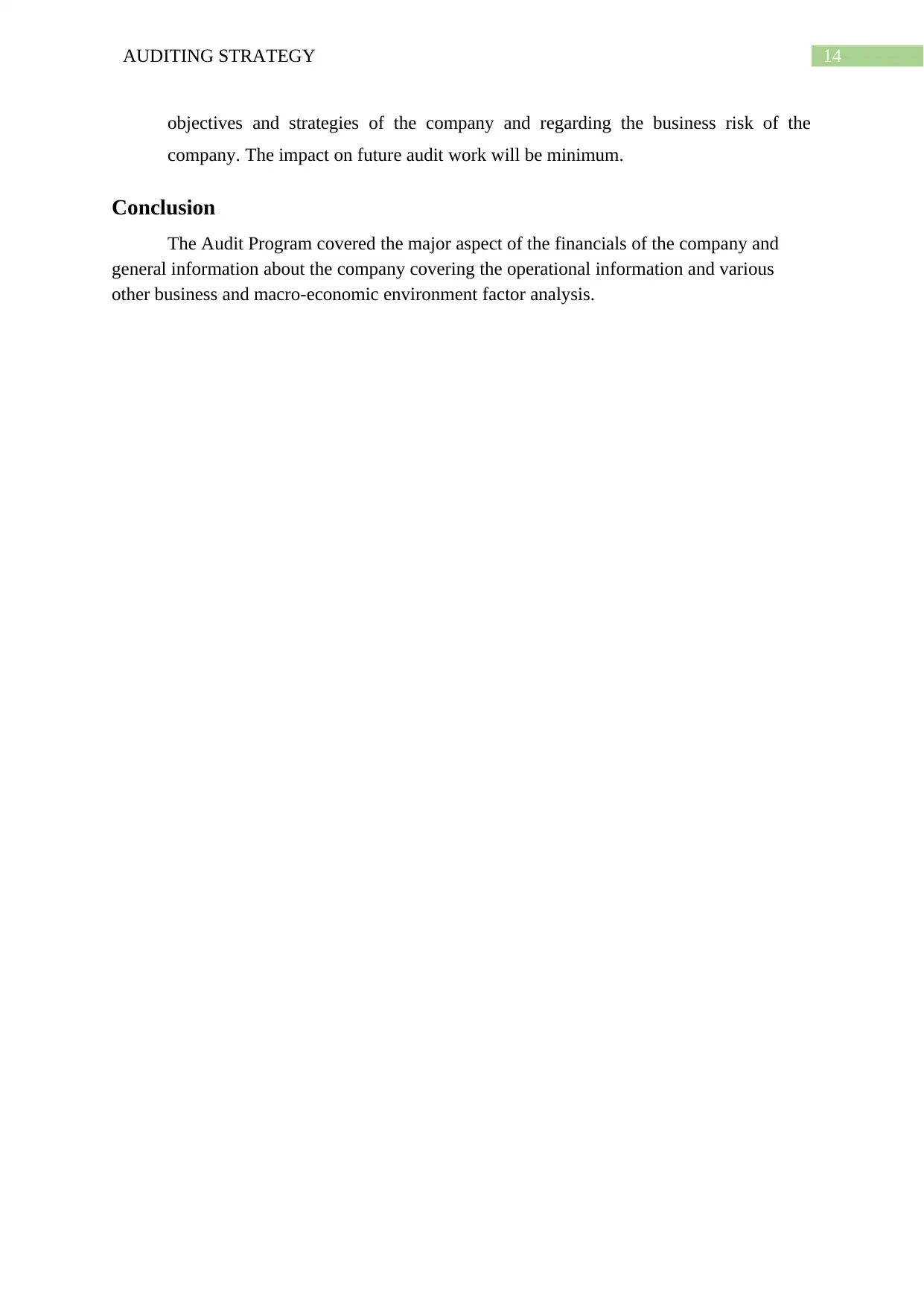
14AUDITING STRATEGY
objectives and strategies of the company and regarding the business risk of the
company. The impact on future audit work will be minimum.
Conclusion
The Audit Program covered the major aspect of the financials of the company and
general information about the company covering the operational information and various
other business and macro-economic environment factor analysis.
objectives and strategies of the company and regarding the business risk of the
company. The impact on future audit work will be minimum.
Conclusion
The Audit Program covered the major aspect of the financials of the company and
general information about the company covering the operational information and various
other business and macro-economic environment factor analysis.

15AUDITING STRATEGY
References
Chapman, A.J., McLellan, B. and Tezuka, T., 2016. Residential solar PV policy: An analysis
of impacts, successes and failures in the Australian case. Renewable energy, 86, pp.1265-
1279. https://www.sciencedirect.com/science/article/pii/S0960148115303402
Christensen, B.E., Glover, S.M., Omer, T.C. and Shelley, M.K., 2016. Understanding audit
quality: Insights from audit professionals and investors. Contemporary Accounting Research,
33(4), pp.1648-1684. https://onlinelibrary.wiley.com/doi/abs/10.1111/1911-3846.12212
Cludius, J., Forrest, S. and MacGill, I., 2014. Distributional effects of the Australian
Renewable Energy Target (RET) through wholesale and retail electricity price impacts.
Energy Policy, 71, pp.40-51.
https://www.sciencedirect.com/science/article/pii/S0301421514002195
Dobele, A.R., Westberg, K., Steel, M. and Flowers, K., 2014. An examination of corporate
social responsibility implementation and stakeholder engagement: A case study in the
Australian mining industry. Business Strategy and the Environment, 23(3), pp.145-159.
https://onlinelibrary.wiley.com/doi/abs/10.1002/bse.1775
El Hanandeh, A., 2015. Energy recovery alternatives for the sustainable management of olive
oil industry waste in Australia: life cycle assessment. Journal of Cleaner Production, 91,
pp.78-88. https://www.sciencedirect.com/science/article/pii/S095965261401289X
Energy.gov.au. 2019. Energy Budget Package 2018-19 | energy.gov.au. [online] Available at:
https://www.energy.gov.au/government-priorities/energy-budget-package-2018-19 [Accessed
20 Feb. 2019].
Groomer, S.M. and Murthy, U.S., 2018. Continuous auditing of database applications: An
embedded audit module approach. In Continuous Auditing: Theory and Application (pp. 105-
124). Emerald Publishing Limited. https://www.emeraldinsight.com/doi/abs/10.1108/978-1-
78743-413-420181005
Gtp.com.au. 2017. Annual Report 2017. [online] Available at:
http://www.gtp.com.au/targetenergy/inewsfiles/Target_ASX_171024_Annual_Report_2017.
pdf [Accessed 21 Feb. 2019].
Hall, N., Lacey, J., Carr-Cornish, S. and Dowd, A.M., 2015. Social licence to operate:
understanding how a concept has been translated into practice in energy industries. Journal
References
Chapman, A.J., McLellan, B. and Tezuka, T., 2016. Residential solar PV policy: An analysis
of impacts, successes and failures in the Australian case. Renewable energy, 86, pp.1265-
1279. https://www.sciencedirect.com/science/article/pii/S0960148115303402
Christensen, B.E., Glover, S.M., Omer, T.C. and Shelley, M.K., 2016. Understanding audit
quality: Insights from audit professionals and investors. Contemporary Accounting Research,
33(4), pp.1648-1684. https://onlinelibrary.wiley.com/doi/abs/10.1111/1911-3846.12212
Cludius, J., Forrest, S. and MacGill, I., 2014. Distributional effects of the Australian
Renewable Energy Target (RET) through wholesale and retail electricity price impacts.
Energy Policy, 71, pp.40-51.
https://www.sciencedirect.com/science/article/pii/S0301421514002195
Dobele, A.R., Westberg, K., Steel, M. and Flowers, K., 2014. An examination of corporate
social responsibility implementation and stakeholder engagement: A case study in the
Australian mining industry. Business Strategy and the Environment, 23(3), pp.145-159.
https://onlinelibrary.wiley.com/doi/abs/10.1002/bse.1775
El Hanandeh, A., 2015. Energy recovery alternatives for the sustainable management of olive
oil industry waste in Australia: life cycle assessment. Journal of Cleaner Production, 91,
pp.78-88. https://www.sciencedirect.com/science/article/pii/S095965261401289X
Energy.gov.au. 2019. Energy Budget Package 2018-19 | energy.gov.au. [online] Available at:
https://www.energy.gov.au/government-priorities/energy-budget-package-2018-19 [Accessed
20 Feb. 2019].
Groomer, S.M. and Murthy, U.S., 2018. Continuous auditing of database applications: An
embedded audit module approach. In Continuous Auditing: Theory and Application (pp. 105-
124). Emerald Publishing Limited. https://www.emeraldinsight.com/doi/abs/10.1108/978-1-
78743-413-420181005
Gtp.com.au. 2017. Annual Report 2017. [online] Available at:
http://www.gtp.com.au/targetenergy/inewsfiles/Target_ASX_171024_Annual_Report_2017.
pdf [Accessed 21 Feb. 2019].
Hall, N., Lacey, J., Carr-Cornish, S. and Dowd, A.M., 2015. Social licence to operate:
understanding how a concept has been translated into practice in energy industries. Journal
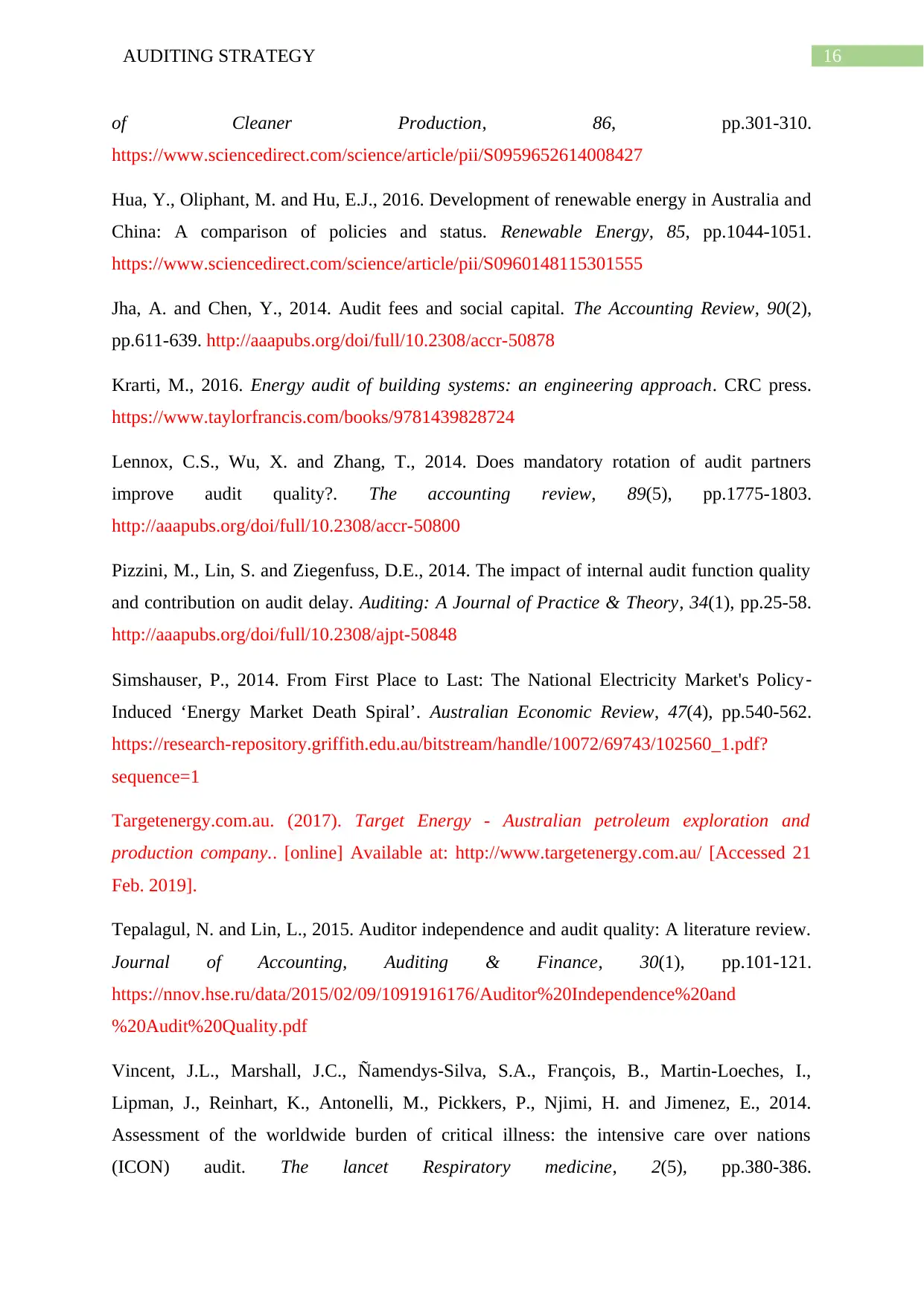
16AUDITING STRATEGY
of Cleaner Production, 86, pp.301-310.
https://www.sciencedirect.com/science/article/pii/S0959652614008427
Hua, Y., Oliphant, M. and Hu, E.J., 2016. Development of renewable energy in Australia and
China: A comparison of policies and status. Renewable Energy, 85, pp.1044-1051.
https://www.sciencedirect.com/science/article/pii/S0960148115301555
Jha, A. and Chen, Y., 2014. Audit fees and social capital. The Accounting Review, 90(2),
pp.611-639. http://aaapubs.org/doi/full/10.2308/accr-50878
Krarti, M., 2016. Energy audit of building systems: an engineering approach. CRC press.
https://www.taylorfrancis.com/books/9781439828724
Lennox, C.S., Wu, X. and Zhang, T., 2014. Does mandatory rotation of audit partners
improve audit quality?. The accounting review, 89(5), pp.1775-1803.
http://aaapubs.org/doi/full/10.2308/accr-50800
Pizzini, M., Lin, S. and Ziegenfuss, D.E., 2014. The impact of internal audit function quality
and contribution on audit delay. Auditing: A Journal of Practice & Theory, 34(1), pp.25-58.
http://aaapubs.org/doi/full/10.2308/ajpt-50848
Simshauser, P., 2014. From First Place to Last: The National Electricity Market's Policy‐
Induced ‘Energy Market Death Spiral’. Australian Economic Review, 47(4), pp.540-562.
https://research-repository.griffith.edu.au/bitstream/handle/10072/69743/102560_1.pdf?
sequence=1
Targetenergy.com.au. (2017). Target Energy - Australian petroleum exploration and
production company.. [online] Available at: http://www.targetenergy.com.au/ [Accessed 21
Feb. 2019].
Tepalagul, N. and Lin, L., 2015. Auditor independence and audit quality: A literature review.
Journal of Accounting, Auditing & Finance, 30(1), pp.101-121.
https://nnov.hse.ru/data/2015/02/09/1091916176/Auditor%20Independence%20and
%20Audit%20Quality.pdf
Vincent, J.L., Marshall, J.C., Ñamendys-Silva, S.A., François, B., Martin-Loeches, I.,
Lipman, J., Reinhart, K., Antonelli, M., Pickkers, P., Njimi, H. and Jimenez, E., 2014.
Assessment of the worldwide burden of critical illness: the intensive care over nations
(ICON) audit. The lancet Respiratory medicine, 2(5), pp.380-386.
of Cleaner Production, 86, pp.301-310.
https://www.sciencedirect.com/science/article/pii/S0959652614008427
Hua, Y., Oliphant, M. and Hu, E.J., 2016. Development of renewable energy in Australia and
China: A comparison of policies and status. Renewable Energy, 85, pp.1044-1051.
https://www.sciencedirect.com/science/article/pii/S0960148115301555
Jha, A. and Chen, Y., 2014. Audit fees and social capital. The Accounting Review, 90(2),
pp.611-639. http://aaapubs.org/doi/full/10.2308/accr-50878
Krarti, M., 2016. Energy audit of building systems: an engineering approach. CRC press.
https://www.taylorfrancis.com/books/9781439828724
Lennox, C.S., Wu, X. and Zhang, T., 2014. Does mandatory rotation of audit partners
improve audit quality?. The accounting review, 89(5), pp.1775-1803.
http://aaapubs.org/doi/full/10.2308/accr-50800
Pizzini, M., Lin, S. and Ziegenfuss, D.E., 2014. The impact of internal audit function quality
and contribution on audit delay. Auditing: A Journal of Practice & Theory, 34(1), pp.25-58.
http://aaapubs.org/doi/full/10.2308/ajpt-50848
Simshauser, P., 2014. From First Place to Last: The National Electricity Market's Policy‐
Induced ‘Energy Market Death Spiral’. Australian Economic Review, 47(4), pp.540-562.
https://research-repository.griffith.edu.au/bitstream/handle/10072/69743/102560_1.pdf?
sequence=1
Targetenergy.com.au. (2017). Target Energy - Australian petroleum exploration and
production company.. [online] Available at: http://www.targetenergy.com.au/ [Accessed 21
Feb. 2019].
Tepalagul, N. and Lin, L., 2015. Auditor independence and audit quality: A literature review.
Journal of Accounting, Auditing & Finance, 30(1), pp.101-121.
https://nnov.hse.ru/data/2015/02/09/1091916176/Auditor%20Independence%20and
%20Audit%20Quality.pdf
Vincent, J.L., Marshall, J.C., Ñamendys-Silva, S.A., François, B., Martin-Loeches, I.,
Lipman, J., Reinhart, K., Antonelli, M., Pickkers, P., Njimi, H. and Jimenez, E., 2014.
Assessment of the worldwide burden of critical illness: the intensive care over nations
(ICON) audit. The lancet Respiratory medicine, 2(5), pp.380-386.
Secure Best Marks with AI Grader
Need help grading? Try our AI Grader for instant feedback on your assignments.
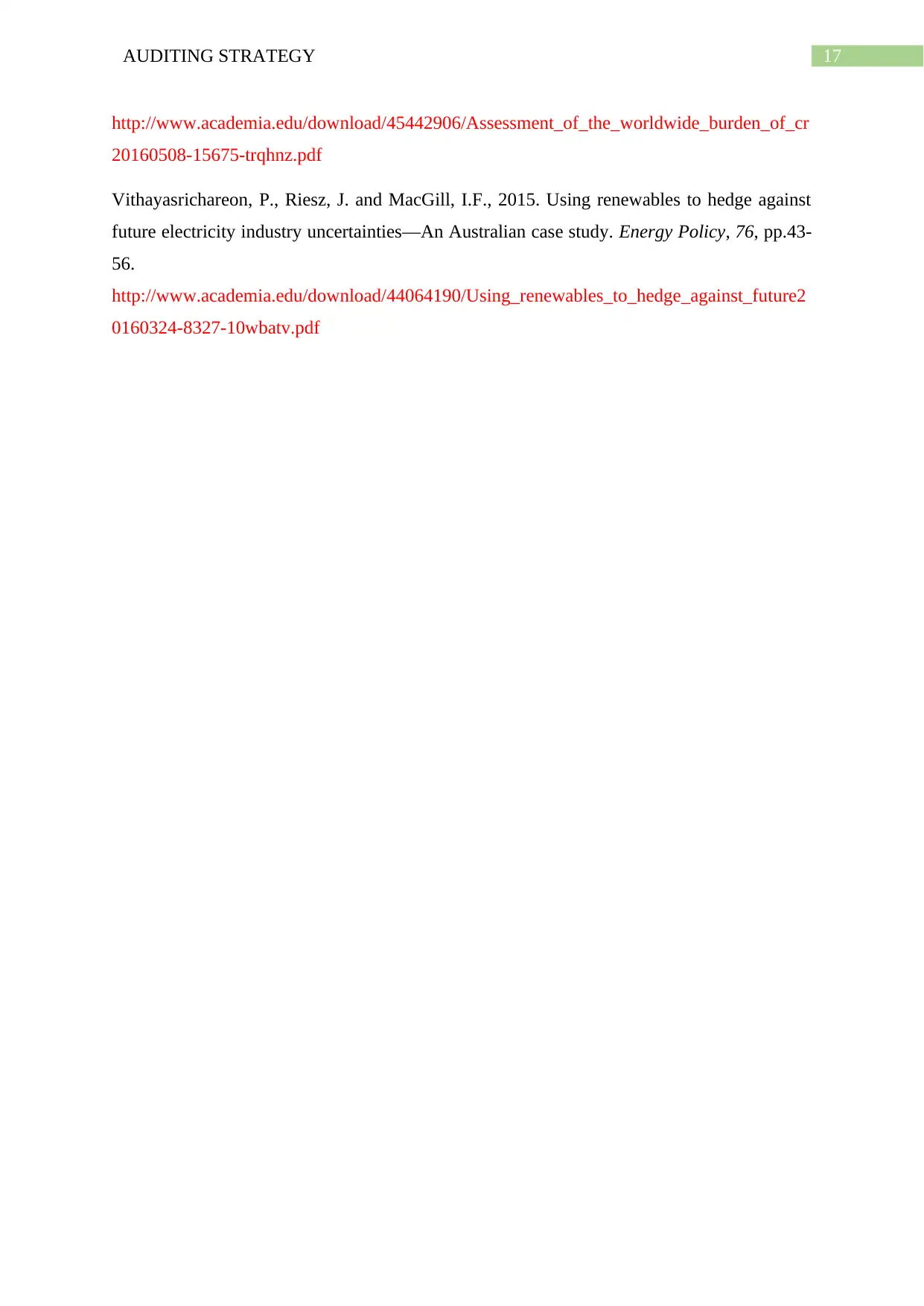
17AUDITING STRATEGY
http://www.academia.edu/download/45442906/Assessment_of_the_worldwide_burden_of_cr
20160508-15675-trqhnz.pdf
Vithayasrichareon, P., Riesz, J. and MacGill, I.F., 2015. Using renewables to hedge against
future electricity industry uncertainties—An Australian case study. Energy Policy, 76, pp.43-
56.
http://www.academia.edu/download/44064190/Using_renewables_to_hedge_against_future2
0160324-8327-10wbatv.pdf
http://www.academia.edu/download/45442906/Assessment_of_the_worldwide_burden_of_cr
20160508-15675-trqhnz.pdf
Vithayasrichareon, P., Riesz, J. and MacGill, I.F., 2015. Using renewables to hedge against
future electricity industry uncertainties—An Australian case study. Energy Policy, 76, pp.43-
56.
http://www.academia.edu/download/44064190/Using_renewables_to_hedge_against_future2
0160324-8327-10wbatv.pdf
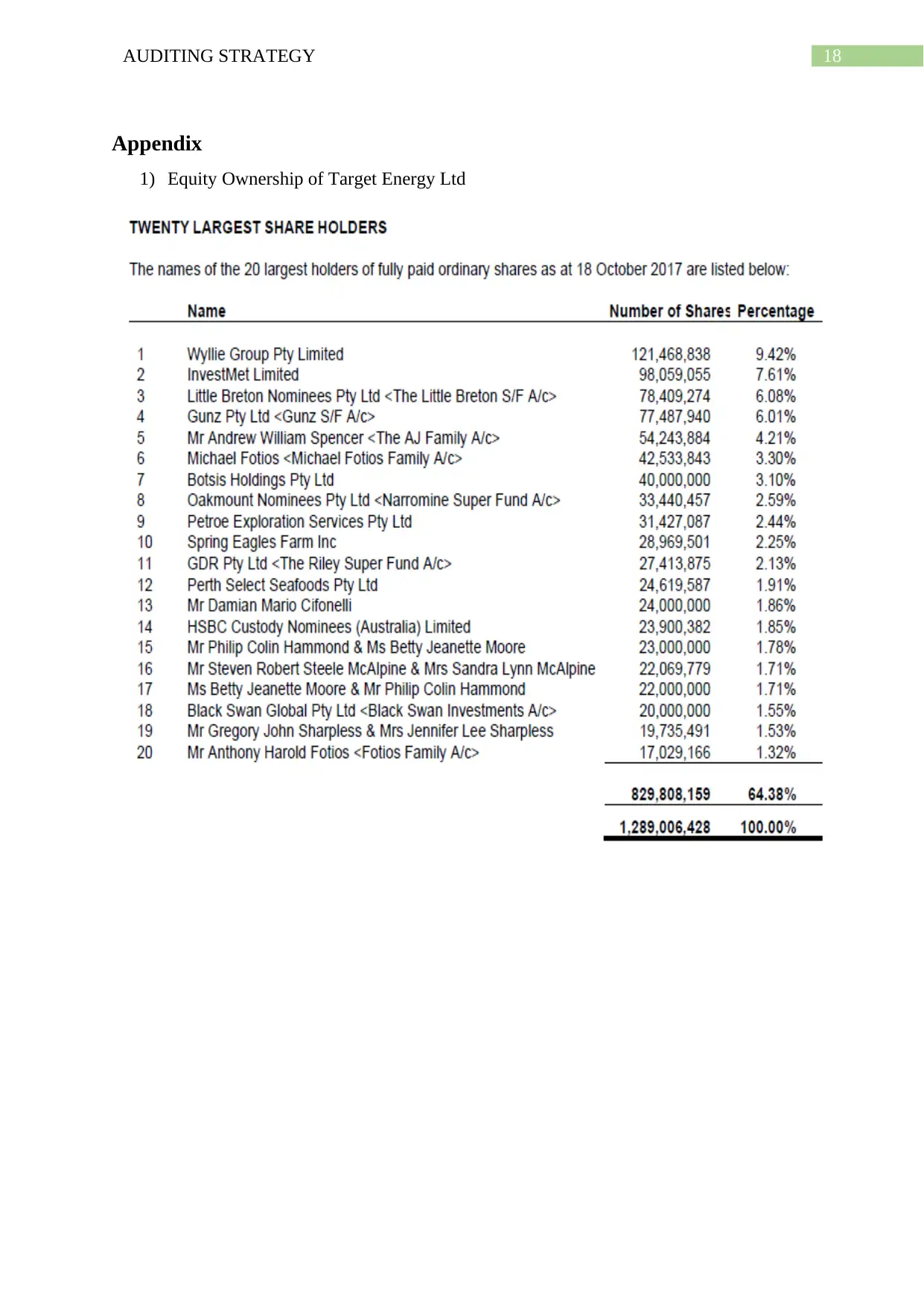
18AUDITING STRATEGY
Appendix
1) Equity Ownership of Target Energy Ltd
Appendix
1) Equity Ownership of Target Energy Ltd
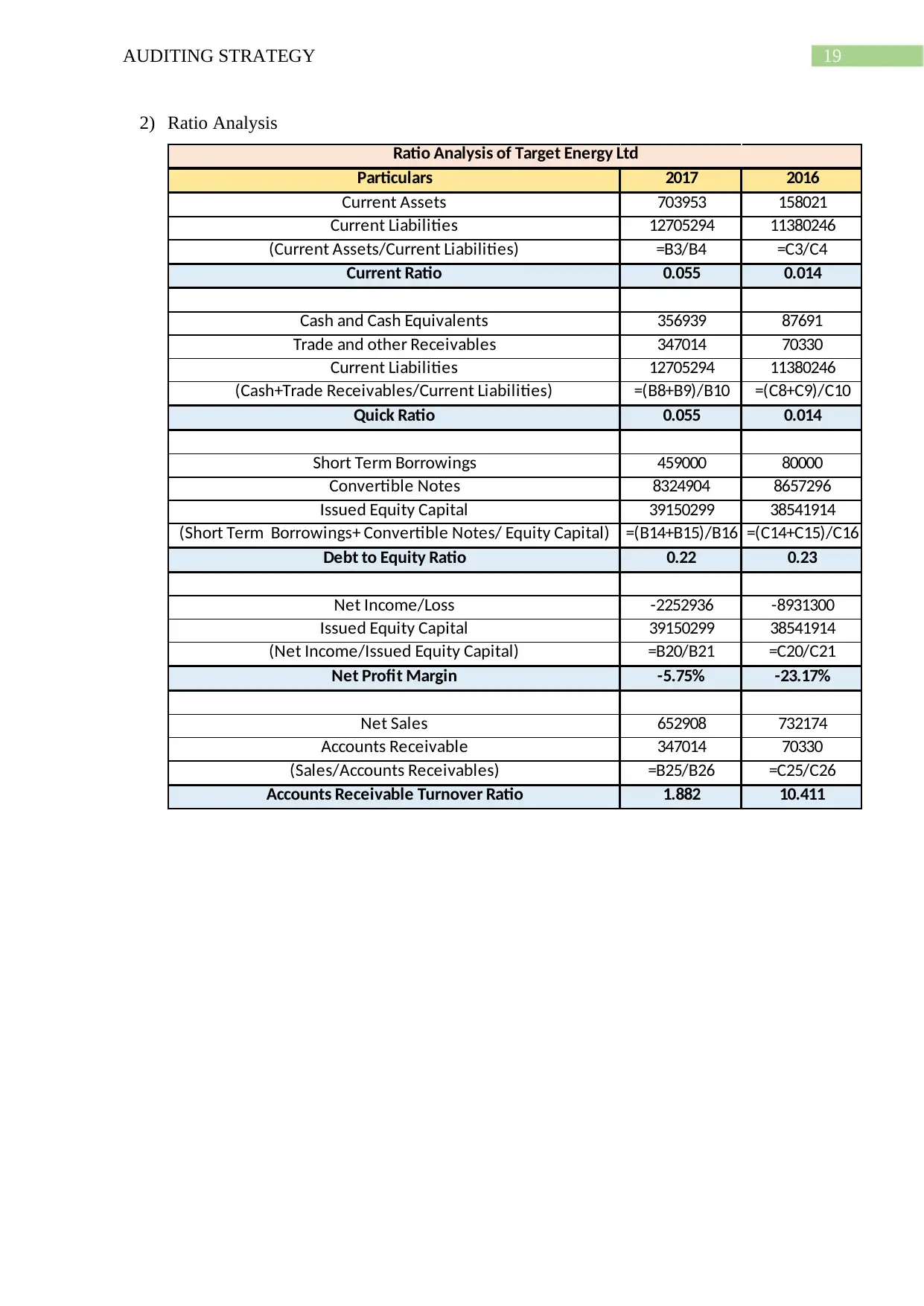
19AUDITING STRATEGY
2) Ratio Analysis
Particulars 2017 2016
Current Assets 703953 158021
Current Liabilities 12705294 11380246
(Current Assets/Current Liabilities) =B3/B4 =C3/C4
Current Ratio 0.055 0.014
Cash and Cash Equivalents 356939 87691
Trade and other Receivables 347014 70330
Current Liabilities 12705294 11380246
(Cash+Trade Receivables/Current Liabilities) =(B8+B9)/B10 =(C8+C9)/C10
Quick Ratio 0.055 0.014
Short Term Borrowings 459000 80000
Convertible Notes 8324904 8657296
Issued Equity Capital 39150299 38541914
(Short Term Borrowings+ Convertible Notes/ Equity Capital) =(B14+B15)/B16 =(C14+C15)/C16
Debt to Equity Ratio 0.22 0.23
Net Income/Loss -2252936 -8931300
Issued Equity Capital 39150299 38541914
(Net Income/Issued Equity Capital) =B20/B21 =C20/C21
Net Profit Margin -5.75% -23.17%
Net Sales 652908 732174
Accounts Receivable 347014 70330
(Sales/Accounts Receivables) =B25/B26 =C25/C26
Accounts Receivable Turnover Ratio 1.882 10.411
Ratio Analysis of Target Energy Ltd
2) Ratio Analysis
Particulars 2017 2016
Current Assets 703953 158021
Current Liabilities 12705294 11380246
(Current Assets/Current Liabilities) =B3/B4 =C3/C4
Current Ratio 0.055 0.014
Cash and Cash Equivalents 356939 87691
Trade and other Receivables 347014 70330
Current Liabilities 12705294 11380246
(Cash+Trade Receivables/Current Liabilities) =(B8+B9)/B10 =(C8+C9)/C10
Quick Ratio 0.055 0.014
Short Term Borrowings 459000 80000
Convertible Notes 8324904 8657296
Issued Equity Capital 39150299 38541914
(Short Term Borrowings+ Convertible Notes/ Equity Capital) =(B14+B15)/B16 =(C14+C15)/C16
Debt to Equity Ratio 0.22 0.23
Net Income/Loss -2252936 -8931300
Issued Equity Capital 39150299 38541914
(Net Income/Issued Equity Capital) =B20/B21 =C20/C21
Net Profit Margin -5.75% -23.17%
Net Sales 652908 732174
Accounts Receivable 347014 70330
(Sales/Accounts Receivables) =B25/B26 =C25/C26
Accounts Receivable Turnover Ratio 1.882 10.411
Ratio Analysis of Target Energy Ltd
1 out of 19
Related Documents
Your All-in-One AI-Powered Toolkit for Academic Success.
+13062052269
info@desklib.com
Available 24*7 on WhatsApp / Email
![[object Object]](/_next/static/media/star-bottom.7253800d.svg)
Unlock your academic potential
© 2024 | Zucol Services PVT LTD | All rights reserved.





